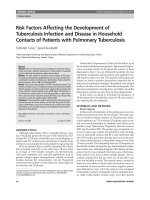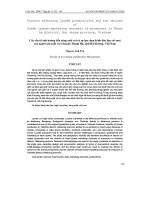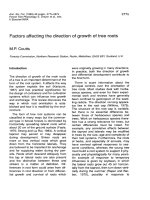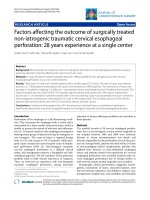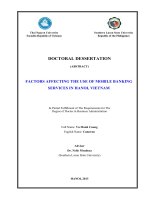Factors affecting the implementation of enterprise resource planning (ERP) at commercial bank of ethiopia
Bạn đang xem bản rút gọn của tài liệu. Xem và tải ngay bản đầy đủ của tài liệu tại đây (1.64 MB, 108 trang )
ADDIS ABABA UNIVERSITY
COLLEGE OF NATURAL AND COMPUTATIONAL SCIENCES
SCHOOL OF INFORMATION SCIENCE
FACTORS AFFECTING THE IMPLEMENTATION OF ENTERPRISE
RESOURCE PLANNING AT COMMERCIAL BANK OF ETHIOPIA
BY
FOZIYA AHMED
JUNE, 2017
ADDIS ABABA, ETHIOPIA
i
ADDIS ABABA UNIVERSITY
COLLEGE OF NATURAL AND COMPUTATIONAL SCIENCE
SCHOOL OF INFORMATION SCIENCE
FACTORS AFFECTING THE IMPLEMENTATION OF ENTERPRISE
RESOURCE PLANNING (ERP) AT COMMERCIAL BANK OF ETHIOPIA
A Thesis Submitted to School of Graduate Studies of Addis Ababa University in
Partial Fulfillment of the Requirements for the Degree of
Master of Science in Information Science
By: Foziya Ahmed
Advisor: Solomon Teferra (PhD)
June, 2017
Addis Ababa, Ethiopia
ii
ADDIS ABABA UNIVERSITY
COLLEGE OF NATURAL AND COMPUTATIONAL SCIENCE
SCHOOL OF INFORMATION SCIENCE
FACTORS AFFECTING THE IMPLEMENTATION OF ENTERPRISE
RESOURCE PLANNING AT COMMERCIAL BANK OF ETHIOPIA
By: Foziya Ahmed Mohammed
Name and signature of Members of the Examining Board
Solomon Teferra (PhD)
Advisor
__________
Signature
________
Date
Ato Getachew Jemaneh
Examiner
__________
Signature
________
Date
Lemma Lessa (PhD)
Examiner
__________
Signature
________
Date
iii
Declaration
This thesis has not previously been accepted for any degree and is not being concurrently submitted
in candidature for any degree in any university.
I declare that the thesis is a result of my own investigation, except where otherwise stated. I have
undertaken the study independently with the guidance and support of my research advisor. Other
sources are acknowledged by citations giving explicit references. A list of references is appended.
Signature: ________________________
Foziya Ahmed
This thesis has been submitted for examination with my approval as university advisor.
Advisor’s Signature: ________________________
Solomon Teferra (PhD)
iv
Acknowledgements
First, I would like to say Alhamdulillah. Next, I would like to express my gratitude to my research
advisor Dr Solomon Teferra, who tirelessly provided me all with the necessary advice, guidance
and comments throughout this study.
My deep thanks are also for my brother Abdu Hassen for his support in all aspect of my life, and
his friends especially Worku and Andarg.
Additionally, my deepest appreciation goes to my family’: my Mom, Dad, brothers and sisters for
their moral and psychological support throughout my study. My especial thanks go to my younger
brothers Yasin and Juhar for their follow-up and invaluable moral support throughout this study.
I’m also grateful to all my friends, especially Fana, Tizita, Elham and Samri for their sincere
friendship and moral support.
Last but not least, I would like to thanks all the Commercial bank of Ethiopia ERP project staffs,
especially Abel, Betty, Lidia, Abebech, Addisu, Mikky, W/ro. Mekiya andW/ro. Haimanot
(project manager).And also all technical teams of batch two who allowed me to do this study in
their Institution. Likewise, I am greatly indebted to all my interview respondents for their
willingness in giving their deep concept of ERP implementation on due date.
Thank you all!
v
Abstract
Enterprise Resource Planning (ERP) systems are software systems for business management,
encompassing modules supporting functional areas such as planning, manufacturing, sales,
marketing, distribution, accounting, financial, human resource management, project management,
inventory management, service and maintenance, transportation and e-business.
When implementing an integrated and big ERP packages in to an organization, assessing the
factors that affect the implementation and sharing experience is very important. Because ERP
systems are complex and need huge budget investment, company re-arrangements and the
implementation, success depends on various technological, organizational and individual factors
of the companies and countries.
ERP success factors are variable and have different degrees of importance depending on the phase
of ERP implementation. Therefore, the study will bridge the gap to find out organizational,
technological, and individual factors affecting the implementation of ERP at each phase of ERP
implementation in the Commercial Bank of Ethiopia.
Commercial bank of Ethiopia is implementing the Oracle ERP into its organization. Focusing on
this company, the purpose of this study is to identify and analyze the organizational, technological,
and individual factors and their influence at each phase of ERP implementation. Based on detail
review of literatures, the researcher selected and used research model for the study that consists
of technological, organizational and individual factors affecting the implementation of ERP
system.
To conduct the study, the researcher has employed a case study in which qualitative research
method was also used to collect and analyze data. Pattern matching technique was used to analyze
the data collected through interview, direct observation and participation.
The research revealed that factors which affect ERP implementation as technological,
organizational and people, the stages of CBE ERP implementation (requirement analysis, solution
design, solution built and test, and production transition and support), the impacts of these factors
vi
in their associated stage and current status (progress) of ERP implementation in commercial bank
of Ethiopia in general.
The research is believed to give an insight into identification of factors affecting the
implementation of ERP system and finally recommend the good management strategy and clear
communication during the implementation of the system is a critical issue to success of the ERP.
Keywords: Enterprise Resource Planning (ERP), ORACLE and ERP Implementation Phases
vii
Table of Contents
Acknowledgement ....................................................................................................................................... iii
Table of Contents ....................................................................................................................................... viii
List of Tables ............................................................................................................................................... xi
List of Figure............................................................................................................................................... xii
Acronyms .................................................................................................................................................... xii
Abstract .......................................................................................................... Error! Bookmark not defined.
CHAPTER ONE ........................................................................................................................................... 1
INTRODUCTION ........................................................................................................................................ 1
1.1. Background of the Study ....................................................................................................................... 1
1.2. Statement of the Problem ....................................................................................................................... 3
1.3. Objective of the Research ...................................................................................................................... 4
1.3.1. General Objective .......................................................................................................................... 4
1.3.2. Specific Objectives ........................................................................................................................ 4
1.4. Significance of the Study ....................................................................................................................... 5
1.5. Scope of the Study ................................................................................................................................. 5
1.6. Organization of the Thesis ..................................................................................................................... 5
CHAPTER TWO .......................................................................................................................................... 7
REVIEW OF LITERATURE AND RELATED WORKS ........................................................................... 7
2.1. Introduction ............................................................................................................................................ 7
2.2. Definition of ERP .................................................................................................................................. 7
2.3. History of ERP ....................................................................................................................................... 8
2.4. ERP Systems ........................................................................................................................................ 10
2.4.1. Oracle Corporation–Flagship Product Oracle Applications......................................................... 10
2.4.2. SAP AG–Flagship Products R/3, mySAP.COM.......................................................................... 11
2.4.3. PeopleSoft Inc.-Flagship Product PeopleSoft8 ............................................................................ 11
2.4.4. The Baan Company–Flagship Product Baan ERP ....................................................................... 12
2.4.5. J.D. Edwards & Co.–Flagship Product One World...................................................................... 12
2.5. ERP Implementation Phase.................................................................................................................. 13
2.6. ERP in Ethiopia.................................................................................................................................... 15
2.7. Factors affecting ERP implementation ................................................................................................ 16
viii
2.8. Related Works ...................................................................................................................................... 19
2.8.1. Summary of Related Researches .................................................................................................. 24
2.9. Research Model ................................................................................................................................... 27
2.10. Summary ............................................................................................................................................ 32
CHAPTER THREE .................................................................................................................................... 33
RESEARCH METHODOLOGY ................................................................................................................ 33
3.1. Introduction .......................................................................................................................................... 33
3.2. Overview of Methodology ................................................................................................................... 33
3.3. Research Purpose ................................................................................................................................. 34
3.4. Research Approach .............................................................................................................................. 36
3.4.1. Quantitative versus Qualitative Research .................................................................................... 36
3.4.2. Inductive versus Deductive Approach ......................................................................................... 36
3.5. Research Method and Strategy ............................................................................................................ 38
3.6. The Case study as a Research Method ................................................................................................. 40
3.7. Case Selection and Sampling ............................................................................................................... 41
3.8. Candidate Selection ............................................................................................................................. 42
3.9. Pilot Interview and Reflection ............................................................................................................. 43
3.10. Data Collection Method ..................................................................................................................... 43
3.10.1. Interview .................................................................................................................................... 44
3.10.2. Observation and Participation .................................................................................................... 45
3.10.3. Document Analysis .................................................................................................................... 46
3.11. Data Analysis Method/Technique ...................................................................................................... 46
3.12. Research Validity and Reliability ...................................................................................................... 47
3.13. Summary ............................................................................................................................................ 48
CHAPTER FOUR....................................................................................................................................... 49
DATA ANALYSIS AND DISCUSSION................................................................................................... 49
4.1. Introduction .......................................................................................................................................... 49
4.2. ERP Implementation at Commercial Bank of Ethiopia ....................................................................... 49
4.2.1. CBE Support Processes Automation by the ERP Systems ............................................................... 51
4.3. Interview Result Analysis .................................................................................................................... 53
4.4. Discussion on Findings of Factors Affecting ERP Implementation Success....................................... 72
4.5. Summary .............................................................................................................................................. 79
CHAPTER FIVE ........................................................................................................................................ 80
ix
CONCLUSION AND RECOMMENDATIONS ........................................................................................ 80
5.1. Introduction .......................................................................................................................................... 80
5.2. Conclusion ........................................................................................................................................... 80
5.3. Recommendations ................................................................................................................................ 82
5.4. Limitation of the Study ........................................................................................................................ 83
Reference .................................................................................................................................................... 92
Appendix A: Letter of cooperation from AAU to CBE ................................................................................ 99
Appendix B: Letter of cooperation from the bank to ERP (PMO) ............................................................. 100
Appendix C: Semi-structured interviews ................................................................................................. 101
x
List of Tables
Pages
Table 2.1: Summary of related researches
30
Table 2.2: Factors affecting ERP implementation at its different stages
36
Table 3.1: Comparison of Inductive and Deductive Research
41
Table 3.2: Characteristics of different research strategies
42
Table 3.3: Interviewee candidate
46
Table 4.1: Interview Result of Factors with their phases
65
Table 4.2: Factors affecting ERP implementation at each phase
83
xi
List of Figure
Pages
Figure 2.1: ERP evolution
8
Figure 2.3: The theoretical Framework
32
Figure 3.1: Framework for the research Paradigm
37
Figure 3.2: Inductive research
41
Figure: 4.1: ERP Application Architecture Overview
59
xii
List of Acronyms
APS
Advanced Planning and Scheduling
APTS
Application Development tools
BI
Business Intelligence
BPR
Business-Processing Reengineering
CBE
Commercial Bank of Ethiopia
CFF
Critical Failure Factor
CRM
Customer Relationship Management
CSF
Critical Success Factors
DBMS
Database Management System
ERP
Enterprise Resource Planning
IC
Inventory control
MIS
Management Information System
MRP
Material Requirements Planning
OSBS
Oracle Small Business Suit
OSM
Office of Strategic Management
PPM
Project Phase Model
R/2
Real-time / 2-tier
R/3
Real-time / 3-tier
SAP
System Application and Products
SCM
Supply Chain Management
T-24
Temonuse 24/7
UAT
User-Acceptance Test
xiii
CHAPTER ONE
INTRODUCTION
1.1. Background of the Study
An information system aims to support operations, management, and decision-making (Kroenk,
2015). Unlike the traditional disintegrated pieces of information systems, Enterprise Resource
Planning (ERP) solution package is one integrated information system with different modules like
finance, human resource management, supply chain management, production planning and so on.
These modules are integrated as one enterprise information system (Rashid et al., 2002).
ERP is the integrated management of core business processes, often in real-time and mediated by
software and technology. The ERP system integrates varied organizational systems and facilitates
error-free transactions and production, thereby enhancing the organization's efficiency. However,
developing an ERP system differs from traditional system development (Shaul and Tauber, 2012).
ERP systems run on a variety of computer hardware and network configurations, typically using a
database as an information repository (Khosrow–Puor, 2006).
Organizations are adopting Enterprise Resource Planning systems to meet the existing challenges
of information era and for competitive advantages. ERP systems facilitate organizations to get the
key business processes to be automated and integrated. ERP systems facilitate timely flow of
information among different parts of the organization freely, which consequently, helps the
management in making strategic decisions. ERP systems are integrated enterprise-wide systems
that automate core enterprise activities such as human resource, manufacturing, finance and supply
chain management etc. to generate and access information in real time environment (Rashid et al,
2002).
The success of ERP implementation is classified into three categories: successful, challenged and
failed (Bearing point, 2004).
Successful ERP project is the one which is within the budget, schedule and up to the
expectations.
1
Challenged ERP project is not within the project budget and schedule but the system is
implemented and being used with minor problems and errors which can be corrected.
Failed ERP is abandoned or not implemented and it is never used.
Many countries, especially the developed ones, have benefited the advantages of ERP systems by
highly adopting these systems since early 1990s (Otieno, 2010). Developing countries are now
adopting ERP. However, regardless of the ERP systems advantages and benefits mentioned here,
developing countries like Ethiopia have not yet adopted and benefited much from such integrative
information solutions (Otieno, 2010), which are usually suited to organizations with large size
businesses or services. Various factors related to ERP implementation success or failure have been
highlighted in the previous studies most of which have been in the developed countries (Shen,
2015).
The history of the Commercial Bank of Ethiopia (CBE) dates back to the establishment of the State
Bank of Ethiopia in 1942. CBE was legally established as a share company in 1963. In 1974, it
was merged with the privately owned Addis Ababa Bank (CBE, 2017). Since then, it has been
playing significance roles in the development of the country both economically and
technologically. The bank is a pioneer to introduce modern banking to the country like Western
Union Money Transfer Services and currently working with other 20 money transfer agents like
Money Gram, Atlantic International (Bole), Xpress Money. It has more than 1160 branches
stretched across the country and four branches in South Sudan. It is the leading African bank with
assets of 384.6 billion Birr as of June 30 2016 (CBE, 2016).
Generally, the Banking industry is growing relatively at a faster rate in Ethiopia than ever before.
The type of services being provided has also improved and supported by modern technologies.
This is due to the fact that number of banks has increased significantly and the competition among
other banks becomes fierce (Rashid, et al, 2002).
As Esteves (2009) stated, the most significant drivers of a huge investment in ERP solutions are
its integration capability, standardization, and improvement of processes, easy information access,
faster decision-making facilities, dissatisfaction with legacy systems, and business consideration.
According to Davenport (2000), the four key drivers of ERP adoption are corporate growth,
2
improved customer service, efficient distribution system, and reduced operational expenses.
Davenport (2000) further stated that some benefits are likely to arise before others start; such as
improved transactional processes and common data under a unified database appear prior to other
benefits that are associated with improvements in management and decision making.
Shang and Seddon (2000) also defined list of ERP benefits from a review of 233 cases published
in ERP vendors’ stories. They also classified the benefits into five benefit categories: operational,
managerial, organizational, IT infrastructure, and strategic.
1.2. Statement of the Problem
ERP is a software package used for integration of organization’s legacy systems like finance,
human resource, SCM, MIS, OSM, etc. The ERP system automates these activities with integrated
application. It also facilitates the flow of information between all business functions inside the
boundaries of the organization. ERP is the most complex software package offered to different
buyers in several sectors of economy to centralized the database in real time working (Abbas,
2015).
There are many ERP vendors, but the major are, SAP (systems applications products in data
processing), Oracle, PeopleSoft, Baan and J.D. But the two most commonly used ERP systems
that are currently used in Ethiopia are SAP and ORACLE ERP systems. Most organizations in
Ethiopia implemented the SAP ERP system while Ethio-telecom has implemented the ORACLE
ERP system. Few researches have been conducted in Ethiopia following the start of ERP
implementation in the country. Abiot and Jorge (2012) have made an assessment on MS-Dynamics
ERP implementation in Mesfin Industrial Engineering. Derese (2013) has conducted a study on
Oracle ERP system at Ethio-Telecom, Sintayehu(2014)reviewed success factors for
implementation of Enterprise Resource Planning system at Ethiopian Airlines and also
Kibebework (2015) has conducted research on the challenges and current status of ERP
implementation at Mugher and Derba Cement industries. Almost all researches in this country are
conducted on SAP ERP system except Derese, who studied Oracle ERP system on Ethio-telecom.
Commercial Bank of Ethiopia (CBE) is one of commercial banks currently running in the country,
which is almost finishing (at production stage) of the Oracle ERP system implementation. When
3
implementing an integrated and big ERP packages in developing countries, assessing the factors
that affect the implementation and sharing experience is very important (Sintayehu, 2014).
Because ERP systems are complex and need huge budget investment, company re-arrangements
and the implementation, success depends on various social, cultural and technical factors of the
companies and countries (Roman, 2009).
Various organizations have different working practices that depend on their culture and nature of
business (Kibebework, 2015). The organizational culture of banking industries differs from the
culture of other organizations. In addition, the different ERP systems have their own unique
implementation methodologies and technical requirements. Other researchers, Markus and Tenis
(2000) suggested that ERP success factors are variable and have different degrees of importance
depending on the phase of ERP implementation. Therefore, the study will bridge the gap to find
out organizational, technological, and individual factors affecting the implementation of ERP at
each phase of ERP implementation in the Commercial Bank of Ethiopia.
Research Question
This paper tries to address the following research questions.
Q1. What are the factors that affect ERP implementation at each phase?
Q2. How do those factors affect each stage of ERP implementation?
1.3. Objective of the Research
1.3.1. General Objective
The general objective of the research is to identify and analyze the organizational, technological,
and individual factors and their influence at each phase of ERP implementation in the commercial
bank of Ethiopia.
1.3.2. Specific Objectives
The specific objectives of the research are to:
Review literature by identifying different papers (researches) which are related to this area
of study.
4
Identify the stages of ERP implementation followed by CBE.
Identify factors affecting ERP implementation in the CBE at each stage.
Forward recommendations for both researchers and the bank.
1.4. Significance of the Study
The main significance of this study is knowledge and experience sharing about ERP systems
implementation between organizations in Ethiopia. The study is also vital for organizations, that
are intended to implement ERP system.
Developed countries that have adopted ERP systems have many failure experiences and histories
of ERP projects. This should not happen to Ethiopian organizations since it can seriously affect
their entire business operations. So, the results of the study could be used as a reference for the
bank and benchmark of ERP system implementation for Ethiopian context. Additionally, it will
help organizations during project preparations, requirement analysis, building team of employee,
ERP vendor selection, implementation partner identification, change management strategy, and
other decisions, which are demanded by enterprise resource planning systems implementations.
Finally, the results of this study can also be used to fill the literature gap on ERP in the Ethiopian
context and can be used as a reference for future research work.
1.5. Scope of the Study
The scope of this research is conducted using a single-case study to investigate the factors affecting
ERP systems implementation by considering the case of Oracle ERP project at CBE. Even though
the results of the study can be extended and applied to other similar organizations and ERP
projects, the focus of the study is around the four main ERP modules, which are fully implemented,
and being used at CBE. The modules are; human resource management, supply chain management,
business intelligence, and finance.
1.6. Organization of the Thesis
The research is organized in five chapters. The first chapter starts with a general introduction about
ERP systems. It explains statement of the problem, the need or significance of the research, its
5
scope and limitations. Chapter two is detailed literature review about ERP, factors affecting ERP
systems implementation, ERP implementation phase and related works. The third chapter
discusses in detail about the methodology of the research, data collection, and analysis techniques.
Chapter four is about analyzing the data, discussion and results. Finally, chapter five contains
conclusions, and recommendations for future works.
6
CHAPTER TWO
REVIEW OF LITERATURE AND RELATED WORKS
2.1. Introduction
This section focuses on definitions of Enterprise Resource Planning (ERP) given by different
scholars, history or evolution of an ERP system through different years and ERP implementation
stages that scholars identified. This section also contains implementation of ERP in banking
industry with its benefits, ERP in Ethiopia which assesses researches conducted on different
companies implemented it, factors affecting ERP implementation, related works done on the area
based on the objective of the study were also deeply presented, research model and finally
summary of the chapter.
2.2. Definition of ERP
Enterprise resource planning systems or enterprise systems are software systems for business
management, encompassing modules supporting functional areas such as planning, manufacturing,
sales, marketing, distribution, accounting, financial, human resource management, project
management, inventory management, service and maintenance, transportation and e-business
(Rashid, et al, 2002).
The enterprise resource planning (ERP) system incorporates a set of programs that provides
support for main organizational activities such as manufacturing and logistics, finance and
accounting, sales and marketing, and human resource. It also helps for sharing of data and
knowledge among different parts of the organization as well as reducing costs, and improves
management of business processes (Adel, 2001).
The architecture of the software facilitates transparent integration of modules, providing flow of
information between all functions within the enterprise in a consistently visible manner. Corporate
computing with ERPs allows companies to implement a single integrated system by replacing or
re-engineering their mostly incompatible legacy information systems. American Production and
Inventory Control Society (2001) has defined ERP systems as “a method for the effective planning
7
and controlling of all the resource needed to take, make, ship and account for customer orders in a
manufacturing, distribution or service company.”
“ERP (enterprise resource planning systems) comprises of a commercial software package that
promises the seamless integration of all the information flowing through the company–financial,
accounting, human resource, supply chain and customer information” (Davenport, 2000).
An ERP system is a vast information system, which enables decision-makers to have an enterprisewide view of the information they need in a timely, reliable and consistent fashion (Kumar and
Hillsgersberg, 2000).
ERP packages are integrated software packages that cover the techniques and concepts employed
for the integrated management of businesses that help effective use of resource, to improve the
efficiency of an enterprise (Ahmed, 2003).
ERP systems are configurable information systems packages that integrate information and
information-based processes within and across functional areas in an organization (Kumar &
Hillsgersberg, 2000). One database, one application and a unified interface across the entire
enterprise (Tadjer, 1998). ERP systems are computer-based systems designed to process an
organization’s transactions and facilitate integrated and real-time planning, production, and
customer response (O’Leary, 2001).
2.3. History of ERP
The evolution of ERP systems closely followed the development in the field of computer hardware
and software systems and the history of ERP systems starts with efforts of automating inventory
control systems in the1960s when most organizations designed, developed and implemented
centralized computing systems for their inventory control systems (Rashid et al, 2002).
During the 1960s most organizations designed, developed and implemented centralized computing
systems, mostly automating their inventory control systems using inventory control packages (IC).
These were legacy systems based on programming languages such as COBOL, ALGOL and
FORTRAN. Material requirements planning (MRP) systems were developed in the 1970s, which
involved mainly planning the product or requirements according to the master production
8
schedule. Following this route new software systems called manufacturing resource planning
(MRP II) were introduced in the1980s with an emphasis on optimizing manufacturing processes
by synchronizing the materials with production requirements. MRP II included areas such as shop
floor and distribution management, project management, finance, human resource and engineering
(Rashid et al, 2002).
ERP systems first appeared in the late 1980s and the beginning of the 1990s with the power of
enterprise-wide inter-functional coordination and integration. Based on the technological
foundations of MRP and MRP II, ERP systems integrate business processes including
manufacturing, distribution, accounting, financial, human resource management, project
management, inventory management, service and maintenance, and transportation, providing
accessibility, visibility and consistency across the enterprise (O’Leary, 2001).
During the 1990s ERP vendors added more modules and functions as “add-ons” to the core
modules giving birth to the “extended ERPs”. These ERP extensions include advanced planning
and scheduling (APS), e-business solutions such as customer relationship management (CRM) and
supply chain management (SCM) (Rashid et al 2002).
Figure 2.1: ERP evolution (source Rashid, et al 2002)
9
2.4. ERP Systems
The major ERP software suppliers are SAP, Oracle, PeopleSoft, Baan and J.D. Edwards. Together
they control more than 60% of the multibillion-dollar global market. Each vendor, due to historic
reasons, has a specialty in one particular module area such as Baan in manufacturing, PeopleSoft
in human resource management, J.D. Edwards runs on multiple platforms with multiple databases,
SAP in logistics and Oracle in financials (Rashid, et al, 2009).
2.4.1. Oracle Corporation–Flagship Product Oracle Applications
Oracle (Oracle, 2001), founded in 1977 in the USA, is best-known for its database software and
related applications and is the second largest software company in the world after Microsoft.
Oracle’s enterprise software applications started to work with its database in 1987. It accounts for
$2.5 billion out of the company’s $9.3 billion in 1999, which places Oracle second to SAP in the
enterprise systems category with over 5,000 customers in 140 countries. Oracles ERP system is
known as Oracle Applications, having more than 50 different modules in six major categories:
finance, accounts payable, human resource, manufacturing, supply chain, and front office.
Oracle has other strong products in the software field including DBMS, data warehousing,
workflow, systems administration, application development tools (APTs), and consulting services.
A notable feature of Oracle is that it is both a competitor and a partner to some of the industry
leaders in the ERP market such as SAP, Baan and PeopleSoft because of the use of Oracle’s DBMS
in their ERP systems (Oracle, 2001).
Oracle has integrated its ERP solutions with the Internet and has introduced several applications
in the electronic commerce and internet based commerce areas. Oracle’s internet infrastructure is
created around two powerful products: Oracle9i Database and Oracle9i Application Server.
Another significant feature of Oracle is its OSBS, or Oracle Small Business Suite, which provides
consistent financials, payroll, inventory control, order entry, purchase orders, and CRM
functionality–all delivered as a Web service. Oracle also offers an easy-to-activate Web presence
that helps companies to sell their goods via the Internet (Oracle, 2001).
10
2.4.2. SAP AG–Flagship Products R/3, mySAP.COM
Five former IBM engineers in Germany started SAP AG (System Applications and Products) in
Data Processing, in 1972 for producing integrated business application software for the
manufacturing enterprise (SAP, 2001). Its first ERP product, R/2, was launched in 1979 using a
mainframe-based centralized database that was then redesigned as client/server software R/3 in
1992. System R/3 was a breakthrough and by 1999 SAP AG became the third largest software
vendor in the world and the largest in the ERP sector with a market share of about 36% serving
over 17,000 customers in over 100 countries. In 1999 SAP AG extended the ERP functions by
adding CRM, SCM, sales-force automation and data warehousing. SAP has also invested
significantly in its R&D sector with the result of newer versions of R/3 3.1, 4.0, 4.6 including
internet functionalities and other enhancements. SAP’s internet-enabled ERP solutions are
provided by the recently launched ERP product called mySAP.COM. SAP has the broadest ERP
functionality, capacity to spend significantly on R&D, strong industry-focused solutions and longterm vision (SAP, 2001).
2.4.3. PeopleSoft Inc.-Flagship Product PeopleSoft8
PeopleSoft is one of the newest ERP software firms started in 1987 in Pleasanton, California, with
specialization in human resource management and financial services modules. PeopleSoft quickly
managed to offer other corporate functions and attained a revenue of $32 million in 1992.
Enterprise solutions from PeopleSoft include modules for manufacturing, materials management,
distribution, finance, human resource and supply chain planning. SAP AG and Oracle–with longer
experience, stronger financial base and worldwide presence–are the main competitors to
PeopleSoft. Many customers comment that PeopleSoft has a culture of collaboration with
customers, which makes it more flexible than its competitors. One of the strengths of PeopleSoft
is the recognition by its customers that it is flexible and collaborative. The flagship application
PeopleSoft8 with scores of applications was developed by PeopleSoft with an expenditure of $500
million and 2,000 developers over 2 years as a pure Internet-based collaborative enterprise system.
“This revolutionary e-business platform is the first open XML platform to offer scalability and
ease of use for all users. PeopleSoft 8 requires no client software other than a standard Web
browser, giving you the ability to securely run your business anytime, anywhere” (PeopleSoft,
2001).
11
“This e-business applications and consulting services enable true global operations–managing
multiple currencies, languages, and business processes for more than 4,400 organizations in 109
countries”. PeopleSoft with about 10% market share, is the third largest ERP vendor after SAP
AG and Oracle (PeopleSoft, 2001).
2.4.4. The Baan Company–Flagship Product Baan ERP
Founded in 1978 in The Netherlands, Baan (Baan, 2001) started with expertise in software for the
manufacturing industry and by 1997 claimed an ERP market share of roughly 5%. Bann’s revenue
in 1998 was roughly $750 million and while facing a slight slowdown in 1999 started growing
again in 2001 with sales up 12% at £7,231million and operating profit of £926 million.
Baan has more than 15,000 customer sites all over the world and more than 3,000 employees. Baan
believes that “the Internet is the ultimate enabler” and “internet technologies help companies
become order-driven and customer focused by enabling collaboration across the ‘value chain.’
Suppliers, distributors, manufacturers and customers can work together to deliver the right product
at the right price” (Baan, 2001).
ERP solution areas that Baan covers include finance, procurement, manufacturing, distribution,
integration and implementation, planning, sales, service and maintenance, business portals,
collaborative commerce and business intelligence. Bann’s flagship product is Baan ERP (formerly
called Triton, then Baan IV), launched in 1998. One innovative product from Baan is the
Organization ware tool that can cut implementation cost significantly by automatically configuring
the enterprise software. Baan’s ERP software is best known in the aerospace, automotive, defense,
and electronics industries (Baan, 2001).
2.4. 5. J.D. Edwards & Co.–Flagship Product One World
J.D. Edwards was founded in 1977 in Denver (cofounded by Jack Thompson, Dan Gregory and
C. Edward McVaney) with long experience of supplying software for the AS/400 market. J.D.
Edwards’ flagship ERP product called One World is “capable of running on multiple platforms
and with multiple databases, etc [and] revolutionizes enterprise software by liberating users from
inflexible, static technologies” (JD Edwards, 2001). The product includes modules for finance,
manufacturing, distribution/logistics and human resource, quality management, maintenance
12


